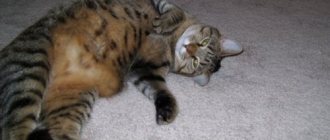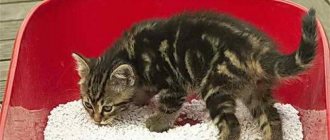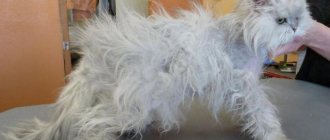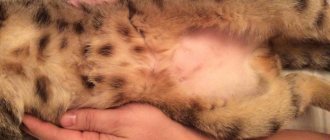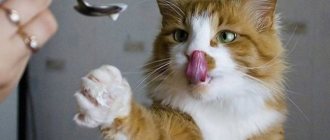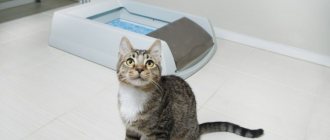When a pet gets sick, its owner falls into a real panic. This is not surprising, because the animal cannot tell what exactly hurts it and how it feels. Based on this, owners of four-legged animals have to search for information on the Internet on their own, studying similar cases, or contacting a specialist in this field.
Sometimes people are interested in the fact that the cat has a bump under its tail. Could this be a symptom of a serious illness or is it nothing to worry about?
Basically, the appearance of seals on the tail is explained by the fact that the animal may have received insufficient care, and its nutrition is not balanced. However, there are other reasons.
Bruises and injuries
If the animal often walks on the street, then a fight could easily occur between several cats. They become especially aggressive at the beginning of spring, as their most romantic period begins. Damage can also occur at the household level. For example, an animal climbed onto a cabinet and fell unsuccessfully. Sometimes pets are injured by their owners, but only through their own negligence.
If damage to the skin occurs, then an infection could enter the body in this place. This often results in abscesses that look like the cat has a lump at the base of its tail. Such a manifestation requires mandatory examination by a doctor.
Demodicosis
This is a fairly common reason for the appearance of a bump on a cat’s tail, which occurs in veterinary practice mainly in the warm season. In this case, we are talking about infecting a four-legged pet with a subcutaneous parasite, which is known to many as a tick.
But some people don’t even realize that it not only begins to suck blood from a helpless animal, but also leads to the development of extremely serious infectious pathologies. A tick can parasitize a cat’s body for quite a long time. Most often, pets who are allowed to walk outside suffer from this pathology. However, a person can also bring ticks on clothes into an apartment.
Causes of tail fractures
External factors lead to vertebral injuries, so street cats often suffer from fractures, in particular, when they fall under the wheels of a car.
Pets, provided they are treated with care by their owners, although they are not immune from this nuisance, suffer from fractures of this part of the body much less often. For example, for most children, pulling a cat's tail is a favorite pastime. Meanwhile, cats react nervously and even aggressively when people touch this organ; needless to say, the injury causes them great discomfort and pain. That’s why it’s so important to explain to kids that simply stroking the pet’s fur won’t do anything bad, but under no circumstances should you drag the animal by the tail.
Sometimes, owners, trying to reason with a naughty pet, spank it on the “soft spot”, but without calculating the force of the blow, they damage the vertebrae. Or, what happens very often, an inquisitive and playful animal simply falls under a person’s feet, and a broken tail is a natural result of such a prank. But the most common source of injury is doors. The cat leaves the object of its pride in the doorway, and the owner, without noticing this, closes the door tightly.
A fracture can also occur as a result of a fight with another animal, or less commonly, an insect bite.
Cancer
Unfortunately, cancer can cause a lump to appear on a cat's tail. In this case, it is necessary to conduct a serious medical examination. Depending on the final diagnosis, appropriate treatment will be prescribed. In some situations, at the initial stage of oncology development, it is possible to fight this disease and achieve a complete cure for the animal.
However, it is very important not to delay the treatment process.
First aid
If the damage is closed and no movement of vertebral fragments is noticeable upon palpation, then this is a good sign.
The wound should be treated with a 3% solution of hydrogen peroxide, if there is bleeding, apply a tight bandage, and the animal should be given an anesthetic, for example, ketofen. A consultation with a doctor is required, as inflammatory processes may develop.
A broken tail requires immediate veterinary attention.
Wounds, bruises, ulcers and abscesses are treated in the usual ways: surgical treatment (using peroxide, dioxidine, Levomekol ointment, Vishnevsky emulsion, etc.), prescribing a course of antibiotics and painkillers. Fractures and dislocations are reduced and fixed using a splint bandage. Contracture (limitation of mobility due to tightening of muscle fibers) is sometimes eliminated by myotomy (cutting, separating muscles) on the healthy side.
Gangrene, advanced purulent processes, complex fractures and crushed vertebrae are reasons for surgical treatment - amputation. After amputation of the tail, the cat does not feel an “inferiority complex” and continues to lead its usual lifestyle.
During treatment, the cat is put on an “Elizabethan” collar, which protects the wound from removal of the bandage and licking.
Main symptoms
If a lump appears on a cat’s tail, then you need to clarify the reasons for this formation. To do this, you need to pay attention not only to the behavior of the animal, but also to the characteristics of the neoplasm itself. If the lump is soft, then in this case it is most likely to be an abscess. This is a dangerous condition.
If a cat has purulent bumps on its tail, then the animal will additionally experience an increased body temperature. Abscesses can be either only on the tail, or throughout the body. In this case, the animal will behave very restless and irritated. Especially when its owner presses on a sore spot. If a cat has a lump on its tail or other alarming signs are observed, then measures need to be taken.
If the formation is solid, then most likely it is a healed fracture of the tail bones. However, such manifestations may also indicate more serious pathologies.
If the animal suffers from the parasitic activity of a tick, then in this case it will immediately experience a number of alarming symptoms. Among them, it is worth highlighting increased body temperature, lethargy, constant apathy, lack of appetite, paleness of the mucous membranes of the eyes and mouth. It will become more difficult for the animal to move, and shortness of breath will appear.
If suspicions fall on a wen or lipoma, then, as a rule, such formations do not manifest themselves at all and remain completely invisible to the animal. The cat will allow itself to be stroked, and at the moment of touching a troublesome place, do not be nervous. As a rule, wen forms if the pet has a metabolic disorder.
Oncological pathologies are the most difficult to manifest. Cancer can remain invisible for a long time both to the owner of the four-legged pet and to himself. To identify this pathology at the very initial stage, it is necessary to periodically conduct a full medical examination of the pet.
Features of treatment
Therapeutic measures are prescribed by the doctor depending on the specific cause that led to the appearance of a bump on the cat’s tail. To do this, you first need to undergo diagnostics and tests.
If we are talking about a purulent abscess or an early stage of cancer, then in this case the intervention of a surgeon is usually required. When a tick or wen appears on an animal’s body, surgery is not always performed. The doctor must take into account the risks depending on the age of the animal and its state of health.
If the lump appears due to a broken bone, then in this case it needs to be cleaned. This procedure is also performed by a specialist. After this, the treated area will need to be periodically lubricated with antibacterial and healing agents prescribed by the doctor. Also, after treatment, you need to give the animal rest and adjust its menu.
Tail anatomy
In order to understand how dangerous a tail fracture can be for a cat, you need to find out what this organ is, how it works, and its importance for the animal.
The cat's tail is an extension of the spine and is attached to the sacrum. It is divided into three parts :
- root - beginning;
- stem – the tail itself;
- the tip completes it.
It consists of numerous vertebrae, their number varies from 19 to 39. The cavities between the vertebrae are filled with a jelly-like substance, which ensures their lubrication and mobility. There are many blood vessels and nerve endings running along its entire length. The muscles of the tail are connected to the muscles of other organs. Therefore, if it is severely injured, displacement of the spine may occur. All this will entail a malfunction in the functioning of other organs: the kidneys, bladder, problems with defecation appear, and nerve innervation is disrupted.
The tail vertebrae are important for the animal to coordinate its movements and orientation in space. You can determine the mood and health status of your beloved pet by looking at the fluffy cat decoration.
Prevention
In order not to guess why a cat has a bump on its tail or any other formations, it is best not to let the animal go outside unnecessarily, especially in the spring. If this is not possible, and the pet still goes for walks periodically, then in this case it is recommended to purchase a special collar, the smell of which will drive away parasites.
To exclude most other problems, you need to review the animal’s diet and balance it so that the cat receives all the necessary mineral components and vitamins. However, allowing obesity is also not recommended.
Sometimes bumps of this type are congenital. They become noticeable immediately after the kitten is born. In this case, the defect does not affect the condition of the animal in any way, so there is no cause for concern. But it’s better to play it safe and rule out other pathologies.
Cleaning a cat's paranal glands
The paraanal glands are located on both sides near the anus; they produce an odorous, thick secretion necessary for the act of defecation, communication with the opposite sex, marking territory and cubs.
Inflammation of the paraanal glands occurs with severe pain and anxiety in the pet, swelling of the extremities, fever and difficulty defecating.
Cleaning the paraanal glands in a cat involves mechanical removal of secretions from inflamed endocrine organs. The procedure should only be performed by a qualified specialist. A veterinarian wearing sterile gloves performs mechanical compression of the inflamed glands with gauze wipes. A liquid, odorous secretion is released under pressure, which brings significant relief from painful symptoms.
When the secretion thickens, the specialist performs a rectal massage of the gland, followed by removal of the thick contents. Sometimes the manipulation is carried out 2-3 times until the bags are completely cleansed.
After cleaning, the cat is prescribed daily rinsing of the paraanal glands with antiseptic solutions using a catheter. If indicated, a course of antibacterial and anti-inflammatory therapy is carried out.



